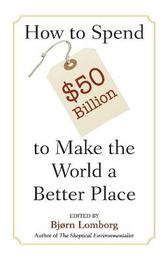
|
How to Spend $50 Billion to Make the World a Better Place
Paperback / softback
Main Details
| Title |
How to Spend $50 Billion to Make the World a Better Place
|
| Authors and Contributors |
Edited by Bjorn Lomborg
|
| Physical Properties |
| Format:Paperback / softback | | Pages:208 | | Dimensions(mm): Height 198,Width 127 |
|
| Category/Genre | Development economics
Political economy |
|---|
| ISBN/Barcode |
9780521685719
|
| Classifications | Dewey:338.9 |
|---|
| Audience | | General | | Tertiary Education (US: College) | | Professional & Vocational | |
|---|
| Illustrations |
7 Tables, unspecified
|
|
Publishing Details |
| Publisher |
Cambridge University Press
|
| Imprint |
Cambridge University Press
|
| Publication Date |
12 June 2006 |
| Publication Country |
United Kingdom
|
Description
Edited by Bjorn Lomborg, this abridged version of the highly acclaimed Global Crises, Global Solutions provides a serious yet accessible springboard for debate and discussion on the world's most serious problems, and what we can do to solve them. In a world fraught with problems and challenges, we need to gauge how to achieve the greatest good with our money. This unique book provides a rich set of dialogs examining ten of the most serious challenges facing the world today: climate change, the spread of communicable diseases, conflicts and arms proliferation, access to education, financial instability, governance and corruption, malnutrition and hunger, migration, sanitation and access to clean water, and subsidies and trade barriers. Each problem is introduced by a world-renowned expert who defines the scale of the issue and examines a range of policy options.
Author Biography
Bjorn Lomborg is Adjunct Professor in the Department of Management, Politics and Philosophy at the Copenhagen Business School and the director of the Danish Environmental Assessment Institute. He is also the author of the controversial bestseller, The Skeptical Environmentalist (Cambridge, 2001).
Reviews'... it is refreshing to read a book that is about a concrete action rather than simply talking.' New Statesman '... makes for good reading on subjects that I encourage all my students to reflect on.' Times Higher Education Supplement
|